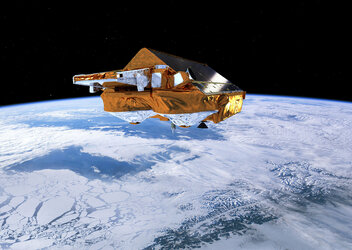Hilary Wilson: EUMETSAT Sentinel-3 Project Manager
In an interview, EUMETSAT’s Sentinel-3 Project Manager Hilary Wilson talks about EUMETSAT’s role in processing and distributing marine data from Sentinel-3 and synergy between this new mission and other satellites.

Hilary, a British national, joined EUMETSAT’s Sentinel-3 project in 2008, initially to manage the organisation’s contribution to the development of the Payload Data Ground Segment (PDGS). In January 2015 she took up the role of Project Manager.
Following a degree in Engineering Geology & Geotechnics in Portsmouth, UK, Hilary completed a Masters in Remote Sensing at University College/Imperial College London and realised that she wanted to pursue a career in the space industry. More than 25 years later she is still passionate about that career choice. Hilary launched her space journey back in 1989 working at the UK Processing and Archiving Facility (UK-PAF) in Farnborough, responsible for processing data from ESA’s ERS-1 and -2 satellites. This led to her finally being Technical Manager of UK-PAF.
In 1996, Hilary moved to Darmstadt, Germany, to join EUMETSAT, working first on the development of the Meteorological Products Extraction Facility for the Meteosat Second Generation and later as the EUMETSAT Polar System (EPS) Data Processing Team Leader. Following commissioning and the handover of the Sentinel-3A satellite and Marine PDGS Centre from ESA to EUMETSAT, Hilary will continue her association with the Sentinel-3 project as EUMETSAT’s Sentinel-3 Mission Manager.
ESA: What is EUMETSAT’s role in processing and distributing Sentinel-3 data?
Hilary Wilson
Together with ESA, EUMETSAT has developed the Sentinel-3 PDGS. EUMETSAT is responsible for providing data for marine applications, while ESA takes care of the equivalent for the land. The PDGS Marine Centre is located in and operated from EUMETSAT headquarters in Darmstadt, Germany. EUMETSAT’s responsibilities related to Sentinel-3 include first of all the generation, long-term archiving and provision to users of the global Level-0/Level-1 and Marine Level-2 products. Soon, these activities will also encompass near-realtime atmospheric products. EUMETSAT also carries out the end-to-end mission planning, the coordination and distribution of all auxiliary data files used for processing to the ESA PDGS centres and the quality control, support to calibration, and validation of the marine Level-2 products. Product distribution relies on EUMETSAT’s existing multimission dissemination mechanisms, EUMETCast and the EUMETSAT Data Centre, which already provide data from our own missions (e.g. Meteosat Second Generation and the EUMETSAT Polar System), and other Copernicus or third party missions (e.g. Jason-3, Suomi-NPP), whose proven infrastructure has now been enhanced to handle Sentinel-3 data as well as via a dedicated Sentinel-3 online rolling archive.
ESA: What is the most challenging part of your job?
Hilary Wilson
The Sentinel-3 project has brought about a new and different way of working with ESA. Despite decades of collaboration and ESA being responsible for the procurement of EUMETSAT satellites, this is the first time that we have jointly developed a ground segment. Both organisations have, of course, developed their own culture and way of working, not to mention their own ‘language’ and never ending list of acronyms. The challenge has been to recognise the differences, understand their relative merits and then to adopt the best solution for Sentinel-3, irrespective of who originally ‘thought of it’! This was not always easy, we had some lively debates but all were followed by Italian coffee and a smile. Each organisation has, I think, benefitted from this more detailed insight into the others’ world.
ESA: What is the relevance of the recently launched Jason-3 satellite for the Sentinel-3 mission?
Hilary Wilson
The launch of the Jason-3 altimeter satellite came at a very opportune moment. Jason-3 continues previous ‘reference altimeter satellites’: TOPEX/Poseidon, Jason-1, and Jason-2. These are considered the backbone of the long-term monitoring of sea-level change. They provide a very consistent dataset starting in 1992 and have always been flying in the same high-altitude non-Sun-synchronous orbit, providing the most accurate picture of variations and trend in the global mean sea level to date. Previous altimeters flown simultaneously with the Jason missions were valuable to further consolidate our view and understanding of regional sea-level variations, and have on countless occasions helped to provide credence or even corrections to the long-term altimeter data record.
Sentinel-3 will fly in a new 27-day repeat orbit not previously occupied by altimeters, and it is essential that we cross-calibrate the Sentinel-3 data with other high-precision altimeters. Both Jason-2 and Jason-3 are perfect for this activity as their tracks will cross those of Sentinel-3 in many locations within a short time interval, allowing us to compare the measurements of sea level, wind speed, and wave height at these points. Sentinel-3's SRAL altimeter is pioneering the global coverage for the next generation of altimeter technology: Delay-Doppler or Synthetic Aperture Radar (SAR) Altimetry. Validation of this novel measurement type via its cross-validation with the more conventional altimetry data provided by Jason-3 will ensure high-quality measurements for many years to come. Also, similar comparisons will be made with SARAL/AltiKa and CryoSat-2 altimeter data, tying them all together in a consistent, long duration set of multimission altimeter data.
ESA: How do you interact with the Copernicus services?
Hilary Wilson
Ultimately, the success of any mission is determined by the satisfaction of the end users, in our case the Marine and later Atmospheric Core Services. Although the mission requirements were established way back at the beginning of the programme, these needs naturally evolve with time and improved understanding. Reacting to these evolutions is critical to ensure we deliver what the services require, which is not always exactly what was originally specified. Hence, we have had regular interactions with our communities throughout the development phase to understand their needs and to adapt the data that we provide, where this is possible, to ensure that we generate what they need. This process will continue throughout the mission to ensure that the Sentinel-3 ground segment continues to meet these needs. A good example of such an evolution is the recent switch of the altimeter to acquire data in full SAR mode. This was not foreseen in the early specification as SAR-mode altimetry was still in its infancy, and therefore the mode was only foreseen to be used over coastal and land surfaces. With the developing knowledge and associated processing techniques, the user community via the European Commission requested that the operational scenario for the Sentinel-3 altimeter be modified to enable the acquisition and full exploitation of these data from the mission start.
Editor's note:
This is one in a series of interviews with some of the key people that are involved in the Sentinel-3 mission. Please check back as further interviews will be added in over the coming weeks.








